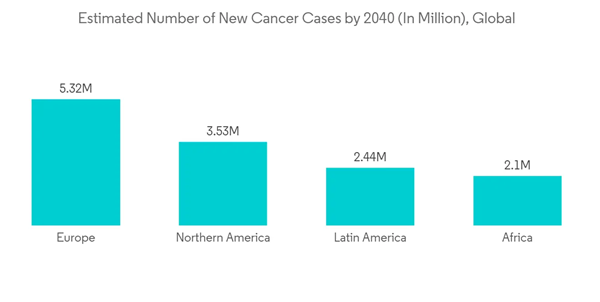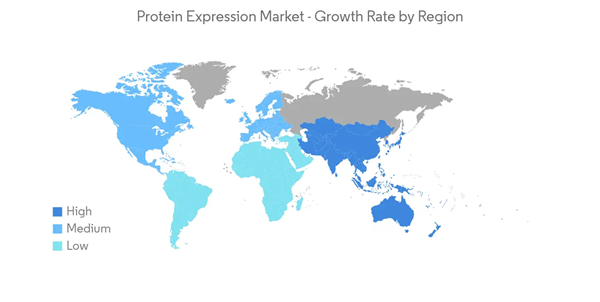The market has a slightly positive impact due to the pandemic. The development of therapeutic and preventive strategies requires an accurate understanding of the role that proteins play in the SARS-CoV-2 infection process and progression of COVID-19. The vast field of proteomics is well equipped with the technologies needed to help in facing this challenge. In an article published in October 2020 in the Journal of Proteins and Proteomics, researchers have highlighted that the developments in proteome technologies will not only accelerate progress in addressing the coronavirus pandemics but could also prove invaluable in tackling the current COVID-19 crisis.
The propelling factors for the growth of the protein expression market include the rise in the R&D activity in the pharmaceutical sector, opportunities in the field of proteomics, and advancements in the biologics market set to boost the market growth and the increasing incidences of chronic diseases. As per the World Health Organization, the major chronic diseases such as cardiovascular diseases (CVD), cancer, chronic obstructive pulmonary disease, and Type 2 diabetes are estimated to account for 73% of all deaths and 60% of the global burden of diseases in 2020.
Biologics have played a crucial role in the treatment process of many health issues. The success of Humira, a drug for the treatment of rheumatoid arthritis, has been an encouraging factor for many drug makers to continue working in the pathway of biologics. The growing demand for biologicals increases the prospects of its manufacturing using the protein expression systems, thus, boosting the market growth.
In addition, biotechnology-based organizations have also created a big opportunity for the protein expression market growth by developing novel therapeutics with minimal side effects. The increasing research intensity in the pharmaceutical sector is adding up to the opportunities for growth by technological advancement and product launch. For instance, in October 2020, Merck launched the Virus Express Lentiviral Production Platform, which can reduce process development time by approximately 40%.
Therefore, at present, the protein expression market is a highly attractive and profitable market due to the increasing adoption of biotechnology as well as genetic engineering in the pharmaceutical industry and medical science. However, the high cost of protein expression systems and lack of effective systems for post-translational modifications are expected to restrain the market growth over the forecast period.
Protein Expression Market Trends
Cell-free Expression is Expected to Hold a Major Market Share in the Protein Expression Market
The cell-free protein expression is well-established in the market, due to its acceptance, and this protein expression is performed without the use of living cells. This technique has many advantages over other protein expression techniques and because of its advantages, it is widely used. Due to the advantages of cell-free protein techniques, such as increased speed, ability to express toxic proteins, ease of amino acid type selective labeling, among others, these are making the cell expression market grow.Furthermore, the growing launches of cell-free systems boost the usage of the kits and reagents. For instance, in 2019, Arbor Biosciences announced the launch of myTXTLTM bulk offerings of cell-free expression systems. These new offerings align with the growing demand for larger volume requirements by organizations utilizing high-throughput screening in protein and enzyme engineering. These cell-free expression systems are currently available from Arbor Biosciences as a Sigma 70 or a linear DNA expression master mix.
Moreover, the growing research and studies on cell-free systems, especially due to COVID is further boosting the growth of the segment. In the article 'Combating COVID-19 with Cell-Free Expression' published in October 2020, synthetic biologists pivoted the cell-free expression technology that they were using for other diseases to develop new diagnostics, materials, and treatments specifically for COVID-19.
Therefore, the unique technology may increase the growth of the cell-free expression market, which in turn, is expected to boost the protein expression market.
North America is the Largest Growing Market and is Expected to Continue the Same Trend Over the Forecast Period
North America is the largest market for protein expression and is expected to dominate the overall protein expression market due to factors like the presence of well-established healthcare infrastructure in these regions combined with the intense R&D activities carried out. The US protein expression market is driven by factors, such as an increase in the usage of protein technologies, the rapid evolution of the pharmaceutical industry in the region, and the presence of several companies in the region itself.As per the January 2021 report of the American Cancer Society, there will be an estimated 1,898,160 new cases of cancer, and 608,570 people will die from it. The increasing demand and acceptance of gene and monoclonal antibody-based therapies in the treatment of diseases such as cancer, rare diseases, and other disorders are also driving the growth of the protein expression market in the region.
According to the Statistics Canada May 2021 report titled 'The Canadian Research and Development Pharmaceutical Sector,' in 2018, the pharmaceutical sector added almost USD 15 billion in value-added to the Canadian economy and spent about USD 1.5 billion to USD 2 billion on research and development during the same period of time.
The growing patient population and growing research and development funding in the region is boosting the market growth.
Protein Expression Industry Overview
The protein expression market is fragmented. The companies present have a broad product portfolio with comprehensive features and have a strong geographical presence. Furthermore, these leaders cater to the requirements of major end users, such as research laboratories and pharmaceutical and biotechnology companies. Some of the companies which are currently dominating the market are Agilent Technologies Inc., Bio-Rad Technologies, Thermo Fisher Scientific Inc., Merck KGA, Takara Bio Inc., New England Biolabs Inc., Oxford Expression Technologies Ltd, Promega Corporation, Qiagen NV, and Sigma-Aldrich Corporation.Additional Benefits:
- The market estimate (ME) sheet in Excel format
- 3 months of analyst support
This product will be delivered within 2 business days.
Table of Contents
Companies Mentioned (Partial List)
A selection of companies mentioned in this report includes, but is not limited to:
- Agilent Technologies Inc.
- Bio-Rad Laboratories Inc.
- Merck KGaA
- New England Biolabs Inc.
- Oxford Expression
- Promega Corporation
- Qiagen NV
- Takara Bio Inc.
- Thermo Fisher Scientific Inc.
- Lonza Bioscience
- Synthetic Genomics Inc.
- Sino Biological Inc.
- Bioneer Corporation










